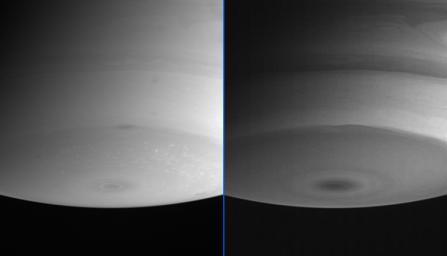Probing Different Depths
Caption:
These two images, taken at about the same time, demonstrate the amazing ability of Cassini's cameras to probe the different layers in Saturn's atmosphere.
While many basic details in the atmosphere are present in both images, a number of subtle details are different. Flecks of bright cloud and a few dark ovals can be seen in the image at left, while at right the contrast between the swirling light and dark bands is most apparent.
The image at left was obtained using a filter sensitive to wavelengths of infrared light centered at 938 nanometers. The image at right is a view taken using a filter centered at 889 nanometers, where methane is most absorbing.
The images were taken with the Cassini spacecraft narrow angle camera on July 24, 2004, at a distance of 6.9 million kilometers (4.3 million miles) from Saturn. The image scale is 41 kilometers (25 miles) per pixel. Contrast was slightly enhanced to bring out features in the atmosphere.
Background Info:
The Cassini-Huygens mission is a cooperative project of NASA, the European Space Agency and the Italian Space Agency. The Jet Propulsion Laboratory, a division of the California Institute of Technology in Pasadena, manages the Cassini-Huygens mission for NASA's Office of Space Science, Washington, D.C. The Cassini orbiter and its two onboard cameras, were designed, developed and assembled at JPL. The imaging team is based at the Space Science Institute, Boulder, Colo.
For more information, about the Cassini-Huygens mission visit,
http://saturn.jpl.nasa.gov
and the Cassini imaging team home page,
http://ciclops.org
.
Cataloging Keywords:
| Name |
Value |
Additional Values |
| Target |
Saturn |
|
| System |
Saturn |
|
| Target Type |
Planet |
|
| Mission |
Cassini-Huygens |
|
| Instrument Host |
Cassini Orbiter |
|
| Host Type |
Orbiter |
|
| Instrument |
Imaging Science Subsystem (ISS) |
|
| Detector |
Narrow Angle Camera |
|
| Extra Keywords |
Atmosphere, Color, Infrared, Methane, Visual |
| Acquisition Date |
|
| Release Date |
2004-09-02 |
| Date in Caption |
2004-07-24 |
|
| Image Credit |
NASA/JPL/Space Science Institute |
| Source |
photojournal.jpl.nasa.gov/catalog/PIA06468 |
| Identifier |
PIA06468 |

 Planetary Data System
Planetary Data System
